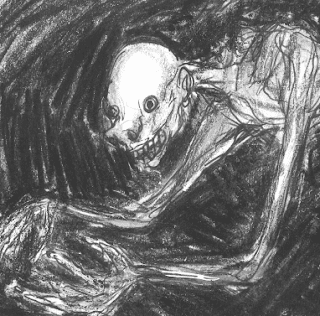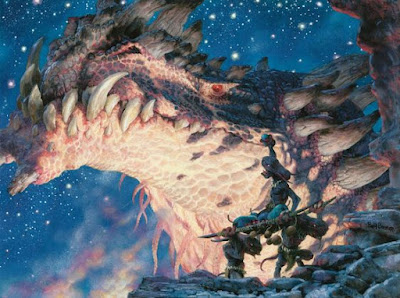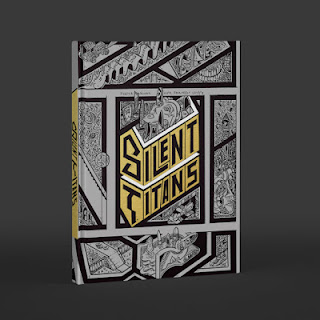A Very Late Review of Deep Carbon Observatory by Patrick Stuart and Scrap Princess
I don't know if starting in medias res worked out very well.
See what I did there?
Jokes aside this is a system neutral module though I believe the implied system is AD&D, though honestly, I am pretty new to the OSR so I can't be sure. Honestly, some things remind me of 5e, but I have no idea if that is intentional. It is an OSR module, really.
One might say that this module doesn't start in medias res but just skips a lot of the fluff that accompanies your usual module. It feels like we are jumping right into the action, one way or another. A little more preamble might have been helpful. Just a summary would be nice. A summary gives an impression of what the intent of the author is. I know that may not matter to some people, but the intent of the author is a useful tool for me to understand how to make sense of the book as a whole.
A summary would also give a roadmap to more easily understand the somewhat complex sequence of events that lead up to and result from the beginning of the adventure. That might sound like coddling but that is the common wisdom of Speech and Debate and I think it applies.
Let me do the same!
What did I like? The creativity, the writing, THE GIANT
What didn't I like? The lack of direction in some areas. The maps. Some of the art.
First, the creativity. Dear Lord, Patrick Stuart, I venerate your dark genius. What else can I say? Everything in here is bubbling with a menacing macabre imagination that titters in the shadows with grim humor. All of the monsters are great. Not a single one fails to be supremely imaginative, funny, or create an interesting encounter. I will get to my favorite monster in a moment. This vision of the Underdark is incredibly compelling and I look forward to reading Veins of the Eart to get more. The idea that it is dark, alien, and spreads out infinitely just below all that you thought was built on solid ground, makes the Underdark almost a Lovecraftian entity, in and of itself.
I thought that the writing expressed this imagination well. People have accused Patrick of having purple prose, but I found the writing of this book to be fairly direct and didn't find it objectionable as I read through.
THE GIANT! Number one, this is the best piece of art in the whole book. I will come back to the art, but here the evocative style (leaving more to your imagination that to exacting details) worked perfectly. I saw this creature and new so many things about its eldritch idiocy and complete defiling of natural laws with its existence. The concept of a thing never meant to walk but always crawl that can contort itself through any space, even though it is so large, is just genius. I love it and I know it will inspire terror and wonderment in players.
On to what I didn't like so much.
One of the things I value in a supplement or game is ease of use. Ease of use means that it is attempting its best to accommodate me as a GM, intending on using it in actual play. Good formatting plays into this but also direction is a helpful thing. I liked that I know how the Crows typically operate but I wanted to know what would bring them to harass the players. It is clear that they want what is in the Vault, but it is less clear why they would, in any way care about the PCs. They are both competing for the treasure, so why not let the PCs get it and attack them afterward? Or let them clear out the intervening obstacles and just follow the whole way? It seems like they like to kill rival adventuring parties but it is unclear what practical purpose this would serve at any point before the Observatory.
Two things might be said about this complaint. #1 if that is what makes sense to you, run it that way. And fine. That's fair.
The other is that you ought to give them a reason to attack the PCs before they come to the dam.
All that is well and good but it isn't easy on the poor GM trying to figure out how to make his game run between having a job and rapidly losing attention span to technological immediacy, not to mention perhaps having to prep more than just this module. My intention right now is to port this into my Weird Marches game which is a hex crawl. I am already going to have to figure out how to shove this area onto some hexes not to mention preparing the other potential areas that the players might decide to visit.
It would be nice to see a little box that said, "Hey, this is how I ran them in my game." I could look at what Mr. Stuart did in his game and reject it utterly or I could take clues from it to inform me of how to use this thing he made. (By the way, if you happen to read this, I would appreciate some tips along these lines. Thanks, I really do love this module in spite of my complaints.)
I am not asking to be coddled but conversed with. I want to understand this wonderful adventure so that I can do it justice and would like a few more tools to do so.
Direction is still a problem when it comes to some of the important things that players ought to be alerted of. The golem stairs in the observatory, activated by special words seem to give no sign that they will attack unless they are given the code words. Since this is a rather important part of the dungeon, I would say some kind of warning or hint would be nice. I could just kill my players until they figure it out, but that seems a little cheap. I have no problem with killing players, but I do like it to be deserved.
I will say more about the maps, but since the maps are kind of complex and hard to read, more text markers to suggest which rooms and doors connect to other rooms would have been helpful. Just: "North door leads to 12." would have helped a lot and not required flipping back to the map or relying on a bookmark.
On to the maps, I like the art for them, especially the observatory itself. I don't find them especially easy to read though. The handwritten numbers and letters are sometimes hard to make out and it isn't always clear how things relate to themselves in three-dimensional space. This spacial vaguery is especially odious in the first chamber of the observatory with the golem stairs. The golem stairs are an important enough part of the dungeon that it would be really nice to make sure I could see what level each exit is on, but I found it difficult to do so.
As for the rest of the art, I just don't know if it did it for me. A few pieces really shine (see THE GIANT) and I thought the map of the Observatory was great. The rest of the art walks on that thin line between avant-garde and bad. I think the art does what it ought to do for the book. It fulfills the purpose and helps build on the unsettling thematics of the entire module. I think it could have been done better, but I don't think any other artist could have done THE GIANT justice. So my opinion on this matter is complex.
Overall, I really like this module for a lot of its content. I think, in an attempt to be artsy, it loses some of the clarity and beauty that I think could otherwise possess. I will use it how I like, but I would appreciate more direction nonetheless. I can't really form a complete opinion on this until I have run this, (and expect a play report once that happens), but I really do like this book and I would say it is worth your money, just for its overwhelming creativity.
I proudly add it to my library. I'll put it right next to the human-leather bound book that screams when opened, containing dark secrets written in radium ink.
See what I did there?
Jokes aside this is a system neutral module though I believe the implied system is AD&D, though honestly, I am pretty new to the OSR so I can't be sure. Honestly, some things remind me of 5e, but I have no idea if that is intentional. It is an OSR module, really.
One might say that this module doesn't start in medias res but just skips a lot of the fluff that accompanies your usual module. It feels like we are jumping right into the action, one way or another. A little more preamble might have been helpful. Just a summary would be nice. A summary gives an impression of what the intent of the author is. I know that may not matter to some people, but the intent of the author is a useful tool for me to understand how to make sense of the book as a whole.
A summary would also give a roadmap to more easily understand the somewhat complex sequence of events that lead up to and result from the beginning of the adventure. That might sound like coddling but that is the common wisdom of Speech and Debate and I think it applies.
Let me do the same!
What did I like? The creativity, the writing, THE GIANT
What didn't I like? The lack of direction in some areas. The maps. Some of the art.
First, the creativity. Dear Lord, Patrick Stuart, I venerate your dark genius. What else can I say? Everything in here is bubbling with a menacing macabre imagination that titters in the shadows with grim humor. All of the monsters are great. Not a single one fails to be supremely imaginative, funny, or create an interesting encounter. I will get to my favorite monster in a moment. This vision of the Underdark is incredibly compelling and I look forward to reading Veins of the Eart to get more. The idea that it is dark, alien, and spreads out infinitely just below all that you thought was built on solid ground, makes the Underdark almost a Lovecraftian entity, in and of itself.
I thought that the writing expressed this imagination well. People have accused Patrick of having purple prose, but I found the writing of this book to be fairly direct and didn't find it objectionable as I read through.
THE GIANT! Number one, this is the best piece of art in the whole book. I will come back to the art, but here the evocative style (leaving more to your imagination that to exacting details) worked perfectly. I saw this creature and new so many things about its eldritch idiocy and complete defiling of natural laws with its existence. The concept of a thing never meant to walk but always crawl that can contort itself through any space, even though it is so large, is just genius. I love it and I know it will inspire terror and wonderment in players.
On to what I didn't like so much.
One of the things I value in a supplement or game is ease of use. Ease of use means that it is attempting its best to accommodate me as a GM, intending on using it in actual play. Good formatting plays into this but also direction is a helpful thing. I liked that I know how the Crows typically operate but I wanted to know what would bring them to harass the players. It is clear that they want what is in the Vault, but it is less clear why they would, in any way care about the PCs. They are both competing for the treasure, so why not let the PCs get it and attack them afterward? Or let them clear out the intervening obstacles and just follow the whole way? It seems like they like to kill rival adventuring parties but it is unclear what practical purpose this would serve at any point before the Observatory.
Two things might be said about this complaint. #1 if that is what makes sense to you, run it that way. And fine. That's fair.
The other is that you ought to give them a reason to attack the PCs before they come to the dam.
All that is well and good but it isn't easy on the poor GM trying to figure out how to make his game run between having a job and rapidly losing attention span to technological immediacy, not to mention perhaps having to prep more than just this module. My intention right now is to port this into my Weird Marches game which is a hex crawl. I am already going to have to figure out how to shove this area onto some hexes not to mention preparing the other potential areas that the players might decide to visit.
It would be nice to see a little box that said, "Hey, this is how I ran them in my game." I could look at what Mr. Stuart did in his game and reject it utterly or I could take clues from it to inform me of how to use this thing he made. (By the way, if you happen to read this, I would appreciate some tips along these lines. Thanks, I really do love this module in spite of my complaints.)
I am not asking to be coddled but conversed with. I want to understand this wonderful adventure so that I can do it justice and would like a few more tools to do so.
Direction is still a problem when it comes to some of the important things that players ought to be alerted of. The golem stairs in the observatory, activated by special words seem to give no sign that they will attack unless they are given the code words. Since this is a rather important part of the dungeon, I would say some kind of warning or hint would be nice. I could just kill my players until they figure it out, but that seems a little cheap. I have no problem with killing players, but I do like it to be deserved.
I will say more about the maps, but since the maps are kind of complex and hard to read, more text markers to suggest which rooms and doors connect to other rooms would have been helpful. Just: "North door leads to 12." would have helped a lot and not required flipping back to the map or relying on a bookmark.
On to the maps, I like the art for them, especially the observatory itself. I don't find them especially easy to read though. The handwritten numbers and letters are sometimes hard to make out and it isn't always clear how things relate to themselves in three-dimensional space. This spacial vaguery is especially odious in the first chamber of the observatory with the golem stairs. The golem stairs are an important enough part of the dungeon that it would be really nice to make sure I could see what level each exit is on, but I found it difficult to do so.
As for the rest of the art, I just don't know if it did it for me. A few pieces really shine (see THE GIANT) and I thought the map of the Observatory was great. The rest of the art walks on that thin line between avant-garde and bad. I think the art does what it ought to do for the book. It fulfills the purpose and helps build on the unsettling thematics of the entire module. I think it could have been done better, but I don't think any other artist could have done THE GIANT justice. So my opinion on this matter is complex.
Overall, I really like this module for a lot of its content. I think, in an attempt to be artsy, it loses some of the clarity and beauty that I think could otherwise possess. I will use it how I like, but I would appreciate more direction nonetheless. I can't really form a complete opinion on this until I have run this, (and expect a play report once that happens), but I really do like this book and I would say it is worth your money, just for its overwhelming creativity.
I proudly add it to my library. I'll put it right next to the human-leather bound book that screams when opened, containing dark secrets written in radium ink.



Comments
Post a Comment